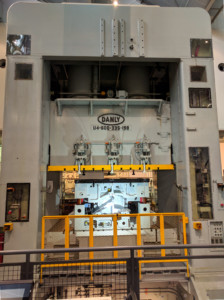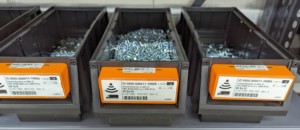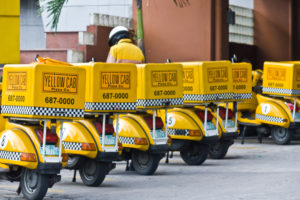 In my last post I gave some basics on how to reduce the lot size in order to reduce both inventory and fluctuations (mura). There are many different reasons why you may have larger lot sizes in the first place. Depending on the root cause, the possible solution may differ. In this and the next post I will look at these different root causes and possible solutions in more detail.
In my last post I gave some basics on how to reduce the lot size in order to reduce both inventory and fluctuations (mura). There are many different reasons why you may have larger lot sizes in the first place. Depending on the root cause, the possible solution may differ. In this and the next post I will look at these different root causes and possible solutions in more detail.
Reducing Lot Sizes Caused by Changeover Time

If you want to improve the lot size due to the changeover time, then your first guess would probably be improving the changeover time through SMED (Single Minute Exchange of Die). Yes… but hold on a minute before starting a SMED workshop.
If the lot size is primarily due to the changeover time, then indeed SMED can help. But often, the lot size based on the changeover is set generously, because manufacturing often just loves large lot sizes. Before you embark on a SMED workshop (which takes a bit of effort and time), first look at the numbers to see if you can reduce the lot size to something less generous but still compatible with the current changeover time. If so, this would improve your lot size with a mere stroke of the pen (and a bit of convincing on the shop floor), and save you a lot of time and effort. If this is enough for a first step, then it would be the easier approach.
However, for a larger improvement, of course, you need SMED to reduce your changeover time. Get your people together, including some that actually do the changeover. Analyze the changeover(s) that cause your large lot size, and improve them. Create a new and improved standard for the changeover. This may be more work, but will yield larger benefits. I have described SMED in a small series of blog posts starting here. As always, do the PDCA and verify that the new changeover sequence actually works and is also still used even a few weeks later.
Reducing Lot Sizes Caused by Container Size

If your lot size is primarily due to your container size, the first thought would be, too, to reduce the size of the container. This is possible, but also more effort and cost to use smaller containers. An interim solution would be simply to fill containers only partially. This is less effort on the hardware, but may need more convincing and working with your people to have them actually fill the container only partially. If it is always the same container, it can help to use a visual indicator on how high the container is to be filled. For example, you could mark the target fill level in a plastic box using a permanent marker. This works especially well if the lot size does not need to be ultra precise (e.g., a box with approximately 100 screws).
 If you decide to use smaller containers, you have a bit more work. You need to obtain smaller containers. Maybe you have them already as part of your storage system, or you may have to buy some. Next you need to look at how the container is used and where it is stored. Do you have to adjust the shelves, supermarkets, or general storage locations to the smaller container size? Do you need to train the workers and update the standard for the smaller container sizes? How are the containers transported? Do you need to update the standards for transport? Do you need to adjust or update the transport equipment? As always, include at least some people in the process that work with these containers, as this will help you with the acceptance of your improvement. As always, do the PDCA and verify that the new container size actually works and is still used properly even a few weeks later.
If you decide to use smaller containers, you have a bit more work. You need to obtain smaller containers. Maybe you have them already as part of your storage system, or you may have to buy some. Next you need to look at how the container is used and where it is stored. Do you have to adjust the shelves, supermarkets, or general storage locations to the smaller container size? Do you need to train the workers and update the standard for the smaller container sizes? How are the containers transported? Do you need to update the standards for transport? Do you need to adjust or update the transport equipment? As always, include at least some people in the process that work with these containers, as this will help you with the acceptance of your improvement. As always, do the PDCA and verify that the new container size actually works and is still used properly even a few weeks later.
Reducing Lot Sizes Caused by Shipment Size

If your lot size is primarily due to the size of the shipment (either from your supplier or to your customer), then the solution is to reduce the sizes of the shipment. However, be prepared that this will raise the blood pressure of your colleagues in accounting, because more shipments for the same volume usually means more shipping cost, which accounting can calculate you down to the cent. Unfortunately, the benefits are hard to calculate even though they are there. Hence, again you have a conflict between measurable cost and immeasurable benefits.

Here, too, are—depending on the circumstances—some different ways to address this issue. If your shipment is a truckload, then smaller shipments mean more trucks. Alternatively, you can consider an external milk run, or generally try to fill your truck with different shipments. Toyota does this very successfully at their main plants in Toyota City, using smaller “gullwing” trucks that are also quick to open from the side. (Note: I have been told that there may be some EU regulations that do not permit this in the EU).
If your shipment is merely a parcel with many other parcels, then less and more frequent parcels have only an additional ordering and handling cost, which is hopefully not too big and won’t be opposed by accounting. Also, to remind you from my last post, while a lot size of one is the ultimate true north, it is not necessarily a sensible next step in many cases.
The next post will conclude these approaches for reducing lot sizes by looking at customer orders, machine batch size, leveling patterns, and tradition. Now, go out, reduce your lot size by reducing changeover time, or container size, or shipment size, and Organize your Industry!
